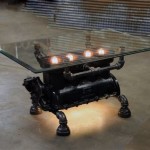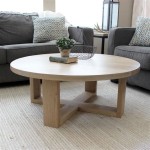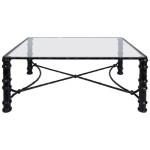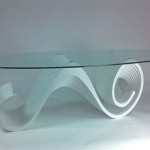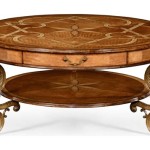How To Find The Center Of A Circular Table Top
Locating the precise center of a circular table top is a fundamental task in various woodworking and crafting projects. Whether for mounting hardware, aligning designs, or creating a perfectly balanced rotating element, accuracy is paramount. Several methods exist for achieving this, each with its own advantages and disadvantages in terms of required tools, ease of execution, and potential for error. This article details several techniques for determining the center of a circle, empowering individuals to select the most appropriate approach for their specific needs and available resources.
Method 1: The Compass and Straightedge Method
This method, rooted in geometry, relies on the fundamental properties of circles and chords. It requires a compass (or a divider) and a straightedge (ruler or any straight object). The accuracy of this method hinges on the precision with which the compass is used to draw arcs and the straightedge is used to connect points. While accurate, this method can be time-consuming.
The first step involves drawing any chord across the circle. A chord is a straight line segment that connects two points on the circumference of the circle. It's crucial that the chord is not a diameter (a line passing through the center). The placement of this first chord is arbitrary and does not affect the final outcome.
Next, construct the perpendicular bisector of the chord. This is accomplished by setting the compass to a radius greater than half the length of the chord. Place the compass point on one end of the chord and draw an arc that extends both above and below the chord. Repeat this process with the compass point on the other end of the chord, ensuring the radius remains the same. The two arcs will intersect at two points.
Using the straightedge, connect the two points where the arcs intersect. This line is the perpendicular bisector of the chord. It passes through the midpoint of the chord and is perpendicular to it. Importantly, the perpendicular bisector of any chord of a circle always passes through the center of the circle.
Repeat the entire process with a second chord. Draw a second chord across the circle, ensuring it is not parallel to the first chord. Construct the perpendicular bisector of this second chord using the same compass and straightedge technique described above.
The point where the two perpendicular bisectors intersect is the center of the circle. This intersection point is equidistant from all points on the circumference of the circle.
To increase the accuracy, particularly with larger circles, a third chord and perpendicular bisector can be constructed. The intersection of all three perpendicular bisectors should ideally converge at a single point. If the lines do not intersect at a perfect point, the center is estimated by the average location within the small triangle or polygon formed by the intersection of the lines.
Method 2: The Right Triangle Method
This method leverages the property that any triangle inscribed in a circle with one side being a diameter is a right triangle. This method requires a straightedge, a right-angled triangle (or a square), and a pencil. The success of this method relies on the accuracy of the right angle of the triangle or square.
Place the right angle of the triangle (or square) with its two sides touching the circumference of the circle. Mark the two points where the sides of the right angle intersect the circle's edge. These two points define a chord.
Using the straightedge, draw a line connecting the two marked points. This line represents a diameter of the circle. However, it is not yet known which point on this line is the exact center.
Repeat the process by positioning the right angle of the triangle at a different point on the circle's circumference and marking two new points of intersection. Draw a line connecting these two points. This line represents another diameter of the circle.
The point where these two diameters intersect is the center of the circle. The accuracy of this method increases with the precision of the right angle and the accuracy of the lines drawn.
This method offers a straightforward approach for finding the center, particularly useful when a compass is not readily available. The key is to ensure a truly accurate right angle is used. Any deviation from 90 degrees in the triangle's corner will introduce error into the results.
Method 3: The Crossing String Method
This method is particularly useful for large circular table tops where using a compass becomes impractical. It relies on measuring and string, and is less precise than the compass or right-angle method, but practical and accessible for larger circles. The accuracy of this method depends heavily on the careful and accurate placement of the string and the precision of the measurements.
First, select any point on the circumference of the circle. Attach one end of the string to this point.
Extend the string across the circle, ensuring it passes through what is estimated to be the center. Mark the point where the string intersects the opposite side of the circumference. This defines a chord which is an approximation of diameter.
Measure the length from the original point on the circumference to the marked point. Mark the midpoint of this distance on the string. This point represents an estimate of the center of the circle. This initial estimation is unlikely to be perfectly accurate.
Now, repeat the process. Attach one end of the string to a different point on the circumference, ideally at a significant angle (approximately 90 degrees) from the first point. Repeat the process of extending the string across the circle, marking the intersection point, and determining the midpoint of the string.
The intersection of the two string segments at their midpoints provides a refined estimate of the circle's center. Depending on the size of the circle and the desired accuracy, the process can be repeated a third or even fourth time, each time choosing a new point on the circumference and finding the midpoint of the extended string. Each iteration refines the approximation of the center.
Due to the inherent inaccuracies in estimating and measuring, the intersection of the strings may not converge at a single, distinct point. Instead, a small area may be enclosed by the intersecting strings. The center of this small area then represents the best estimate of the table top's center.
This method is best suited for cases where high precision is not critical, or when other methods are not feasible due to the size of the circle. It is more of an approximation technique rather than a mathematically precise one.
Method 4: Using a Center Finder Tool
For those seeking a quicker and more convenient solution, specialized center finder tools are available. These tools are designed to accurately determine the center of circular objects. These tools vary in design, but commonly involve a combination of rulers or sliding arms that converge at the center.
One type of center finder tool consists of two arms that pivot and intersect at a point. The arms are placed against the edge of the circular table top, and when properly aligned, the point of intersection indicates the center. The arms are often inscribed with rulers or scales to provide visual confirmation of the alignment.
Another type of center finder is designed as a sliding ruler. The tool is placed across the circle, and a sliding mechanism adjusts until the ruler spans the maximum width of the circle. The center point is then marked on the ruler, representing the center of the circle.
The accuracy of these tools depends on the quality of their construction and the precision of their scales and mechanisms. It is essential to select a center finder tool from a reputable manufacturer to ensure reliable results.
Center finder tools offer advantages in terms of speed and ease of use. They eliminate the need for complex geometric constructions and manual measurements. However, they may be less accurate than the compass and straightedge method if the tool itself is not precisely manufactured.
Furthermore, the size of available center finder tools may limit their applicability to larger circular table tops. For very large circles, other methods may be more practical.

How To Find The Center Of A Circle 3 Easy And Quick Ways

How To Graph A Circle Equation Examples Lesson Study Com
Finding The Center Of A Round Square Or Rectangular Table Top

How To Find The Center Of A Circle 4 Steps Instructables

How To Build A 70 Round Dining Table Honey Built Home

How To Build A 70 Round Dining Table Honey Built Home

How To Build A 70 Round Dining Table Honey Built Home

How To Build A 70 Round Dining Table Honey Built Home

How To Calculate The Best Dining Table Size For Your Room

Solved Circular Table In Amanda And Emily S Apartment A Round Is Shoved Into The Corner Of Room Touches Two Walls At Points That Are 17 Inches Apart
Related Posts


